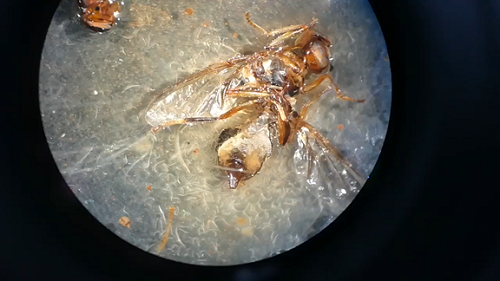Doctor Sitaram Aryal
Candidature
Graduated PhD 2022
Thesis title
Characterisation of Entomopathogenic Nematodes and their symbiotic bacteria across Eastern Australia and their potential in controlling Queensland Fruit Fly
Research project
 The Queensland fruit fly (QFF), Bactrocera tryoni (Froggatt), is one of Australia’s worst horticultural tephritid fruit fly pest insects. It attacks fruit and fruiting vegetable crops from over 40 plant families making it one of the most polyphagous and most economically important species among all tephritids. Fruit flies have so far been effectively controlled with chemical insecticides. However, many of these have since been abolished because of their environmental and human health risks. Thus, there is a need to find an alternative control options that are safe for humans, beneficial insects and the environment. One of the options is the use of native and commercially available natural enemies like entomopathogenic nematodes (EPNs).
The Queensland fruit fly (QFF), Bactrocera tryoni (Froggatt), is one of Australia’s worst horticultural tephritid fruit fly pest insects. It attacks fruit and fruiting vegetable crops from over 40 plant families making it one of the most polyphagous and most economically important species among all tephritids. Fruit flies have so far been effectively controlled with chemical insecticides. However, many of these have since been abolished because of their environmental and human health risks. Thus, there is a need to find an alternative control options that are safe for humans, beneficial insects and the environment. One of the options is the use of native and commercially available natural enemies like entomopathogenic nematodes (EPNs).
Entomopathogenic nematodes of the families Heterorhabditidae and Steinernematidae are biological control agents (BCA) for a variety of economically important pest. They are known to have a worldwide distribution, have a short generation time and exist in the soil only as the free-living third stage infective juveniles (IJs). The IJs are obliged to survive in the soil, seek for insect hosts, penetrate their target via natural openings and deliver a few cells of the bacterial symbiont into the insect hemocoel. These bacterial symbionts produce different toxins and secondary metabolites that are lethal to the insect hosts.

Figure 1: Bactrocera tryoni adult infected with EPNs
The search for EPN has led to a generation of fresh genetic materials with numerous isolates and strains. To date, almost 90 Steinernema and around 19 Heterorhabiditis species have already been described worldwide. However, only less than 6% of total EPNs has been described from Australian soils. Australia, being a diverse continent is most likely to present a plethora of EPNs that can be used effectively as a BCA of B. tryoni. It is therefore essential to isolate and identify EPNs from this area and assess their virulence against the target insect. In addition, despite the current upsurge in surveys to discover native EPN species, their efficacy and success entail a comprehensive knowledge and understanding of the biology, ecology and distribution in our fluctuating environment. For instance, obtaining environmental parameters associated with the prevalence of EPN during surveys unravel some crucial factors that drive the distribution of these nematode species. There is also a need to define specific relationship between EPNs and the symbiotic bacteria along with their phylogeography. With this fundamental information, a better management strategy for the noxious insect, B. tryoni will be possibly obtained which to date still remains to be a challenge. Thus, the main aim of this study is to acquire nematode-bacteria isolates with higher virulence, faster host seeking, longer persistence that remain reproductive.

Figure 2 : Tenebrio infected with EPNs
Awards
- Industrial Transformation Postgraduate Research Award, Western Sydney University, Australia
- VLIR-UOS scholarship (Flemish Interuniversity Council-University Development Cooperation) for the study of ‘Master of Science in Nematology’ at Ghent University, Belgium.
- Tribhuvan University Merit Based Scholarship for the study of B.Sc. Ag. at Rampur Campus
Supervisors
Associate Professor Markus Riegler and Associate Professor Uffe Nielsen
Publications
Aryal S, Nielsen UN, Sumaya NH, De Faveri S, Wilson C, Riegler M, (2022) 'Isolation and molecular characterization of five entomopathogenic nematode species and their bacterial symbionts from eastern Australia', BioControl, vol.67, pp 63-74
Aryal S, Nielsen UN, Sumaya NH, Wilson C, Riegler M, (2022) 'Effect of temperature on survival of Australian entomopathogenic nematodes and their virulence against the Queensland fruit fly, Bactrocera tryoni', Biocontrol, vol.67, no6, pp 617-628
Aryal S, Nielsen UN, Sumaya NH, Wilson C, Riegler M, (2022) 'Virulence, penetration rate and reproductive potential of entomopathogenic nematodes from eastern Australia in Queensland fruit fly, Bactrocera tryoni', Biological Control, vol.169, Article no.104871
Leonar AL, Nimkingrat P, Aryal S, Martinez JG, Bhat AH, Sumaya NH, (2022) 'Natural association of the entomopathogenic nematode Heterorhabditis indica (Rhabditida: Heterorhabditidae) from the Philippines with the non-symbiotic bacterium Ochrobactrum anthropi (Proteobacteria: Brucellaceae)', Egyptian Journal of Biological Pest Control, vol.32, no.1, Article no.83
Ramos RJ, Ann Dichusa C, Aryal S, Crispolon E, Sumaya NPD, Sumaya NH, (2022) 'Isolation, identification and virulence of the local entomopathogenic nematode Heterorhabditis indica in the southern Philippines against the sugarcane white grub, Leucopholis irrorata (Chevrolat) (Coleoptera: Scarabaeidae)', International Journal of Tropical Insect Science, vol.42, no.3, pp 2739 - 2750
Dichusa CA, Ramos R, Aryal S, Sumaya NPD, Sumaya NH, (2021) 'Survey and identification of entomopathogenic nematodes in the province of Cotabato, Philippines, for biocontrol potential against the tobacco cutworm, Spodoptera litura (Fabricius) (Lepidoptera: Noctuidae)', Egyptian Journal of Biological Pest Control, vol.31, no.1, Article no.60
Navarez ML, Sangcopan R, Aryal S, Sumaya NPD, Bhat AH, Sumaya NH, (2021) 'Native Philippine Heterorhabditis indica isolates from banana and rice fields and preliminary results of their virulence against the larvae of super worm (Zophobas morio Fabricius Coleoptera: Tenebrionidae)', Egyptian Journal of Biological Pest Control, vol.31, no.1, Article no.46
Sumaya NH, Aryal S, Vandenbossche B, Barg M, Doerfler V, Strauch O, Molina C, Ehlers R-U, (2017) 'Phenotyping dauer juvenile oxidative stress tolerance, longevity and persistence within wild type and inbred lines of the entomopathogenic nematode Heterorhabditis bacteriophora', Nematology, vol.19, no.8, pp 971-986